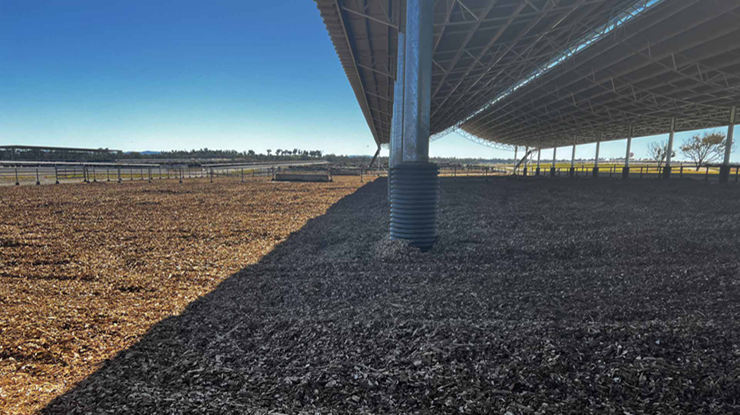Partial pen coverage a solid solution for feedlots
02 October 2024
 One of the pens used in ‘Evaluation of partial pen coverage’ project
One of the pens used in ‘Evaluation of partial pen coverage’ project
Feedlot cattle that have access to sheds with bedding generally perform better than cattle with no shade, an MLA-funded project has found.
The ‘Evaluation of partial pen coverage with shelter in a commercial feedlot’ project measured the effects of partially covered housing and woodchip bedding in long-fed Angus cattle in the final 110 days of their feeding period.
An exploration into effects of climate on feedlot cattle
MLA engaged Bovine Dynamics and the site host, Rangers Valley Feedlot in Glen Innes NSW, to help develop solutions to mitigate the effects of climate on cattle.
Dr Melissa George from Bovine Dynamics explains how the project was designed.
"In summer, there’s increased solar radiation and heat, which can negatively impact animal comfort and performance,” Melissa said.
“The New England region is a winter rainfall environment, hence conditions are commonly wet and cold during winter.
“The project was designed to mitigate negative environmental conditions, allowing cattle to remain in their thermoneutral zone."
According to Melissa, there is a building body of science showing that when cattle (or animals in general) can make choices relating to their environment, there is a positive impact for their mental state and animal welfare. Improved animal welfare was one of the drivers of this project.
The project's design
The project was run during both the summer and winter seasons to evaluate whether there were any differences between them. Researchers examined 5,280 animals which were randomly allocated to three different treatments. Eight blocks of 660 animals, randomly allocated to three treatments, with each pen containing 220 head of cattle were used.
Three treatments were compared over the final 110 days of the feeding period for long-fed Angus cattle:
- Unshaded with woodchip bedding (control)
- Partial shelter cover with woodchip bedding
- Partial shelter cover without woodchip bedding.
Alex Smith, Feedlot Manager at Rangers Valley, explained why they use woodchip bedding with their cattle despite it not being very common in the Australian feedlot industry, and the benefits they have found after using it for the last 10 years.
"Given the weight of our cattle and the length of feeding, we run a pretty heavy woodchip program,” Alex said.
"We’ve found that bedding greatly impacts animal comfort, welfare and performance. We haven't done much research on this, so it was important to evaluate the bedding as part of this project."

The shed was designed to allow for effective air circulation and cooling.
Findings and evaluation
According to Dr Matt George, Managing Director of Bovine Dynamics, the shed for this project was designed to allow effective air circulation and cooling (attributes not common in older sheds).
It was found that cattle under the shed with bedding did the best in many of the evaluation categories.
An increased feed intake was recorded in cattle that had access to partial coverage and bedding, alongside an increased feed conversion rate, average daily gain and exit weight.
"We found that the cattle were not only eating more, but they were converting better,” Matt said.
"They were using less energy resources in a comfortable environment. Being comfortable, they would have a lower respiration rate and a lower full body temperature, meaning less energy is used.”
Matt also mentioned using the woodchip bedding had a big impact on musculoskeletal health.
While onsite with his team monitoring the cattle in day-to-day operations, Alex spoke about what he observed throughout the project and highlighted how interesting it was to see the cattle's behaviour in the shed.
"We got the first rain event, and the cattle initially all moved out of the shed because the noise worried them, but once they got used to the shed and acclimatised to it, we noticed they were coming and going out of the covered area quite regularly,” Alex said.
"At any one time, there would be about two-thirds of the cattle under the shed and one-third outside, and they would rotate. It didn't matter the weather conditions; they still chose to rotate between covered and outside. This allowed them to self-regulate between the two.
"As a general observation, we found the cattle seemed a lot more comfortable across both winter and summer periods with the option of the shed coverage."
What it means for the industry
Partial pen coverage may be a good solution for more challenging environments, such as higher altitude or higher rainfall environments, according to Dr Matt George.
"If we think about the areas around Victoria, where there is a higher chance of quite high rainfall, providing that choice of pen coverage for cattle is a big benefit," he said.
Providing partial pen coverage also allows operators to abide by best practice animal welfare guidelines. Providing shade reduces the risk of discomfort through self-thermal regulation, reduces the risk of cattle heat load and improves a feedlot's resilience to climate variability.
Once available, the final report will be on the MLA feedlot management research and development page here. You can also hear Dr Melissa George discuss the project further at the upcoming BeefEx Conference from 15–17 October.


